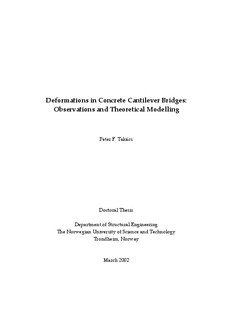| dc.contributor.author | Takács, Peter F. | nb_NO |
| dc.date.accessioned | 2014-12-19T11:24:26Z | |
| dc.date.available | 2014-12-19T11:24:26Z | |
| dc.date.created | 2002-03-20 | nb_NO |
| dc.date.issued | 2002 | nb_NO |
| dc.identifier | 121731 | nb_NO |
| dc.identifier.isbn | 82-471-5415-3 | nb_NO |
| dc.identifier.uri | http://hdl.handle.net/11250/231135 | |
| dc.description.abstract | The thesis deals with the deformation problem of segmental, cast-in-place concrete cantilever bridges. This type of bridge has shown some propensity to develop larger deflections than those were predicted in the design calculation. Excessive deflections may lead to deterioration of aesthetics, serviceability problems and eventually early reconstruction of the bridge. Also in the construction stages the deflections have to be properly compensated to achieve the smooth camber in the completed bridge deck.
Deformation prediction in concrete cantilever bridges is not as reliable as it would be necessary due to several factors. The high degree of uncertainty in creep and shrinkage prediction in concrete constitutes the major difficulty. Other factors are the complex segmental construction procedure and the sensitivity of the deformations to variations in the construction schedule, the uncertainty in estimating the frictional loss of prestress and relaxation in the prestressing tendons and uncertainty in estimating model parameters such as temperature and relative humidity.
The doctoral study was initiated with the objective to improve deformation prediction in segmentally cast concrete cantilever bridges and to establish guidelines for deformation analysis based on advanced numerical methods.
A database on observed deformations in three modern long span concrete cantilever bridges in Norway has been established. Two of the bridges were partly constructed from lightweight aggregate concrete. The deformations have been monitored since the construction stages up to the present time. The measurements cover the construction stages and the service life of 14, 8 and 3 years, respectively for the three bridges. The measured deformations are deflections in the superstructure and in one of the bridges, also strain measurements in the piers and the superstructure.
A sophisticated numerical model was created for deformation analysis. The numerical model realistically simulates the segmental construction procedure and the entire life span of the bridge. The effects of the segmental construction method, temporarily supports and constraints and changes in the structure system during construction are taken into account. The model considers the different concrete age from segment to segment, the sequential application of permanent loads and prestressing and the effect of temporary loads. The prestressing tendons are individually modelled with their true profile taking into account the variation of the effective prestressing force along the length of the tendon and with time.
The finite element model consists of beam elements which are based on an advanced beam element formulation. The beam model was verified against a robust two-and-a-half dimensional shell model concerning its general performance and some specific issues. The comparison confirmed the accuracy of the beam model. Existing experimental data on creep and shrinkage in lightweight aggregate concrete and high strength concrete were evaluated in comparison with theoretical models. The main focus was on the CEB-FIP Model Code 1990 and its subsequent extensions. The findings were considered in the numerical studies.
Deformations of the three bridges were computed. The CEB-FIP Model Code 1990 material model was used for concrete for the most part. The elastic moduli were taken from test results where they were available. The creep coefficient and the shrinkage strain of the lightweight aggregate concrete were assumed equal to those of normal density concrete of the same strength. The agreement between the calculated and the measured deformations were satisfactory in view of the large uncertainty involved in theoretical prediction. While moderate differences were observed in most cases, no clear overall tendency toward underor overestimation was found. In subsequent numerical studies, the sensitivity of the deformations to variations in various model parameters was investigated. The B3 model was compared to the CEB-FIP Model Code 1990 in the analysis of one of the bridges, where the latter model showed somewhat better agreement with the measurements.
The last part of the work concerned a robust probabilistic analysis which was based on a Monte Carlo simulation. The objective of the probabilistic analysis was to estimate the statistical properties of the deformation responses. With the distribution function of a given deformation response being known, the confidence limit for the deformation can be determined. It is recommended to design the bridge for the long-time deflection which represents a certain confidence limit (e.g. the 95 % confidence limit) of the response rather than its mean. Such way the risk that the bridge will suffer intolerable deflection over its life span can be minimised. | nb_NO |
| dc.language | eng | nb_NO |
| dc.publisher | Fakultet for ingeniørvitenskap og teknologi | nb_NO |
| dc.relation.ispartofseries | Dr. ingeniøravhandling, 0809-103X; 2002:23 | nb_NO |
| dc.subject | Engineering design | en_GB |
| dc.subject | TECHNOLOGY: Engineering mechanics: Construction engineering | en_GB |
| dc.title | Deformations in Concrete Cantilever Bridges: Observations and Theoretical Modelling | nb_NO |
| dc.type | Doctoral thesis | nb_NO |
| dc.source.pagenumber | 189 | nb_NO |
| dc.contributor.department | Norges teknisk-naturvitenskapelige universitet, Fakultet for ingeniørvitenskap og teknologi | nb_NO |
| dc.description.degree | dr.ing. | nb_NO |
| dc.description.degree | dr.ing. | en_GB |
